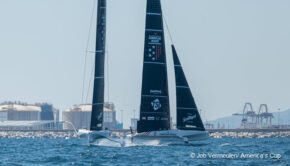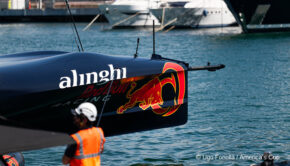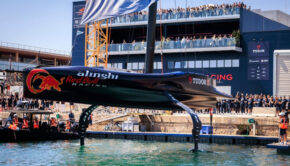Henry Paget: Owner of the America’s Cup
Published on February 16th, 2021
by Dr. Hamish Ross
In the long history of the America’s Cup, only one man has ever owned the Cup outright.
We all know how it was won by the yacht America, giving the Cup its name and gifting by the owners of the yacht for perpetual international friendly competition. It is now for all future time in the hands of a winning yacht club, who acts as the Cup’s (temporary) trustee, until it is won by a challenge of another foreign yacht club.
As is also well-known, the Cup was purchased from the first ever appointed Royal Jewellers, R & S Garrard, who had built the Cup around 1848, at least that is when British silver tax was paid on the Cup, as evidenced by two sets of hallmarks one on its lip and another on the original base. Interestingly, the year stamp of 1848 on the Cup did not until 1973, align with a calendar year.
The hallmarking year letter stamp were changed on the day that the Goldsmith’s Guild wardens were elected, originally this was St Dunstan’s Day (19 May) until the Restoration of the Crown in 1660, when it was moved to Restoration Day (also known as Oak Apple Day) on 29 May until 1973, when it became aligned to a calendar year. This means the Cup was hallmarked and silver tax paid on it sometime between 29 May 1848 and 28 May 1849.
The purchaser of the Cup was Field Marshall Henry William Paget, 1st Marquess of Anglesey, Earl of Uxbridge, Baron Paget, de Beaudesert, and was also an Irish Baronet, of Plas Newydd in the County of Anglesey and of Mount Bagenall in the County of Louth, Knight of the Order of the Garter, Knight Grand Cross of the Order of the Bath and Knight of the Grand Cross of the Royal Guelphic Order.
It is fair say that you could hear him walk when formally dressed with loud gilded clinks.
Paget presented the Cup to the Royal Yacht Squadron for use as a prize. There is no evidence that it was then destined to become the prize for the Squadron’s “all nations” race held on 22 August 1851, but sometime later it was allocated by the Squadron to the famous race and the rest is international sporting history.
Who was Henry Paget?
Born in London in 1768, he was the eldest son of Sir Nicolas Bayly, an Anglesey Baronet (the lowest rank in the British aristocracy) a descendant of an advisor to King Henry VIII. His father inherited, the barony of Paget from a second cousin, giving him a step up the aristocratic ladder as a Baron, when he changed his surname to Paget. Henry, his son then become Lord Paget.
Around a dozen years later, his father having served a number of civil government posts, was promoted to an earldom and became the Earl of Uxbridge. At the outbreak of the Napoleonic Wars, his son, our Henry Paget, raised a regiment of volunteers in Staffordshire and he thereafter rose rapidly in the regular army ranks from Lieutenant to Lieutenant-General within fifteen years, serving with success both in Flanders and Spain as a cavalry commander of note.
His military career was suddenly interrupted in 1809 when he was at the centre of one of the biggest scandals of Georgian England, following his elopement with the Duke of Wellington’s sister in law, Lady Charlotte Cadogan, a mother of four, leaving his wife and eight children. Her brother challenged him to a duel which took place on Wimbledon Common. Both fired their pistols and honour was deem to be satisfied.
Novelist Jane Austin, wrote of the marriage of Paget’s eldest daughter to the Duke of Richmond, “What can be expected from a Paget, born & brought up in the centre of conjugal Infidelity & Divorces?”
A divorce were granted to both couples by Parliament allowing Paget and Charlotte to marry and they remained happily so for the remainder of their years as evidenced by having a further nine children. Wellington steadfastly refused to have anything to do with him during his Spanish Peninsula campaigns against Napoleon’s forces on account of the scandal.
A still resentful Wellington, appointed Paget his cavalry commander in 1815 during Hundred Days, a campaign culminating with the Battle of Waterloo, where Paget acquitted himself well, leading spectacular charge of the Heavy Cavalry to check and help rout the French Army at a critical juncture during the Battle.
Paget lost his right leg to one of the last French cannon shots of the day when he was close to Wellington and was said to have remarked, “By God, sir, I’ve lost my leg!” To which Wellington relied “By God, sir, so you have!”
The remains of leg were amputated and later buried to become a late Georgian and Victorian tourist attraction in the village of Waterloo.
After the Battle, Paget was promoted in the English aristocracy and created the Marquess of Anglesey. He and Wellington became reconciled in their twilight years. Paget went on to serve in many civil posts including twice as Lord Lieutenant of Ireland where he pushed for Catholic emancipation and state-aided education for children, much to the annoyance of his Government.
Paget was a lifelong keen sailor, one of the original founder members in 1815 of The Yacht Club, formed at the Thatched House Tavern in London 1 June 1815 in London, which later became, with Royal patronage, the Royal Yacht Squadron. He was at the time serving in Belgium, about to fight the Battle of Waterloo.
His main racing yacht was the Pearl, a very successful cutter of 113 tones. It was said to be built by a Philip Sainty a well-known builder of fast smuggler cutters, who happened to be in Springfield jail for smuggling offences.
Paget secured a pardon from the King to have his yacht built, but Sainty refused to come out of jail until his brother and brother-in-law were similarly pardoned, so that Paget was forced to secure pardons for all three to have the Pearl built. He raced hard often for high stakes, once agreeing to burn his yacht if she was beaten, fortunately, she narrowly won.
Paget visited the America after she arrived in Cowes and declared “If she’s right, we must all be wrong”. He was saved from falling overboard while aboard the America by Commodore Stevens who grabbed his wooden leg as Paget lent over the rail looking for a secret propeller he was convinced she must have.
He leased Cowes Castle until his death when the Royal Yacht Squadron acquired the lease of it’s now world famous club house.
Paget died on 24th April 1854, was given a state funeral and is buried at Lichfield Cathedral in Staffordshire. The present Marquess is the 8th Marquess, Charles Paget who succeeded to the family suite of titles in 2013.
The America’s Cup international competition is the generous product of two gifts. The one we all know well, that of the New York Yacht Club Commodore John Cox Stevens and his four fellow member friends, but also a lesser known earlier one of the Henry Paget, the first Marquess of Anglesey.












 We’ll keep your information safe.
We’ll keep your information safe.